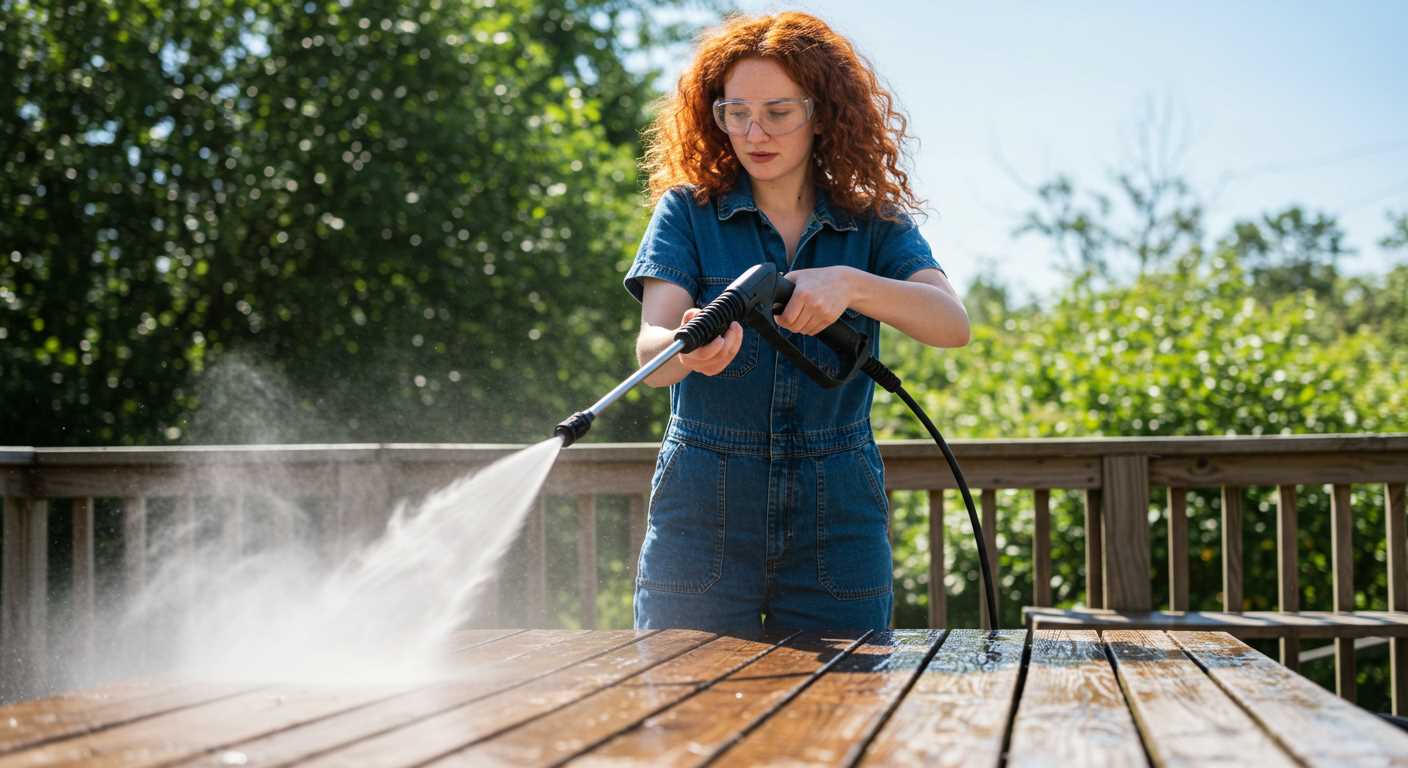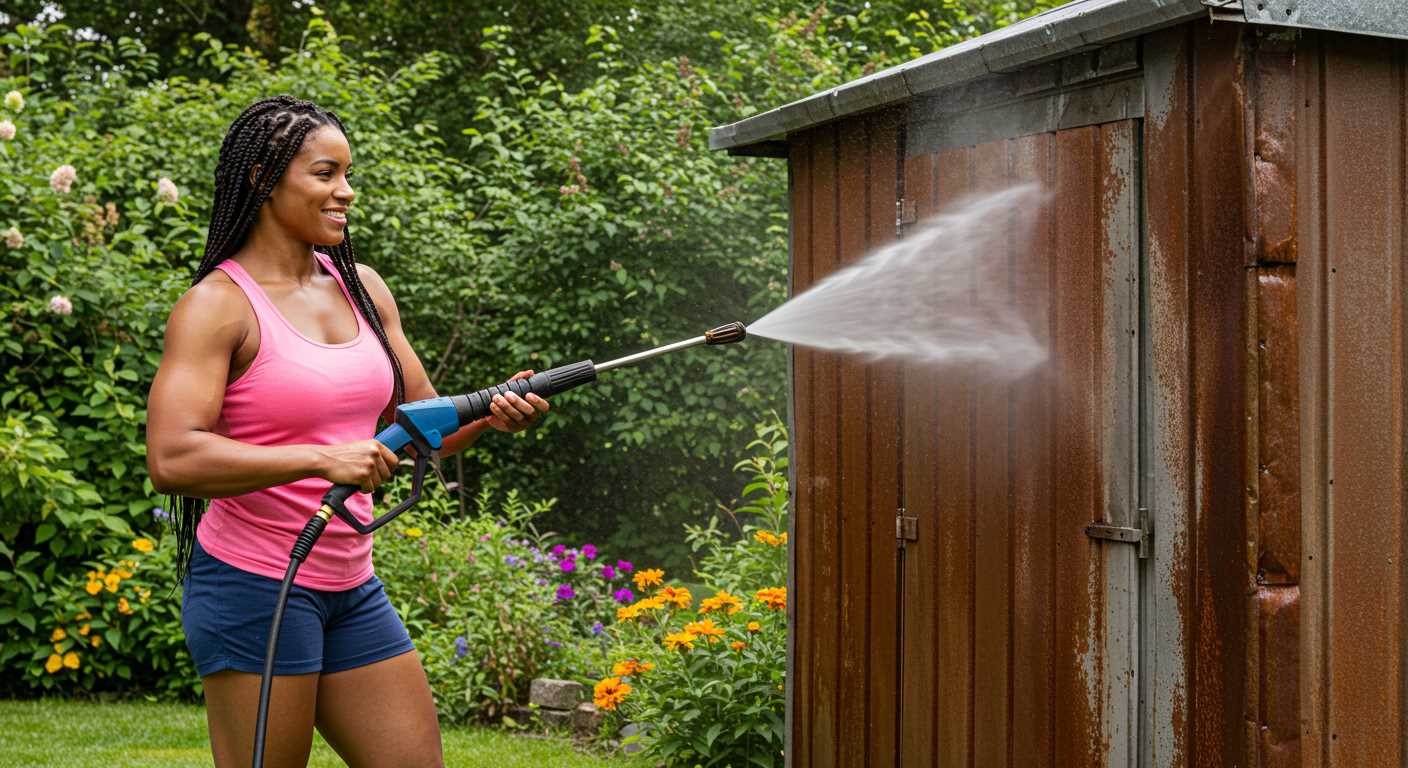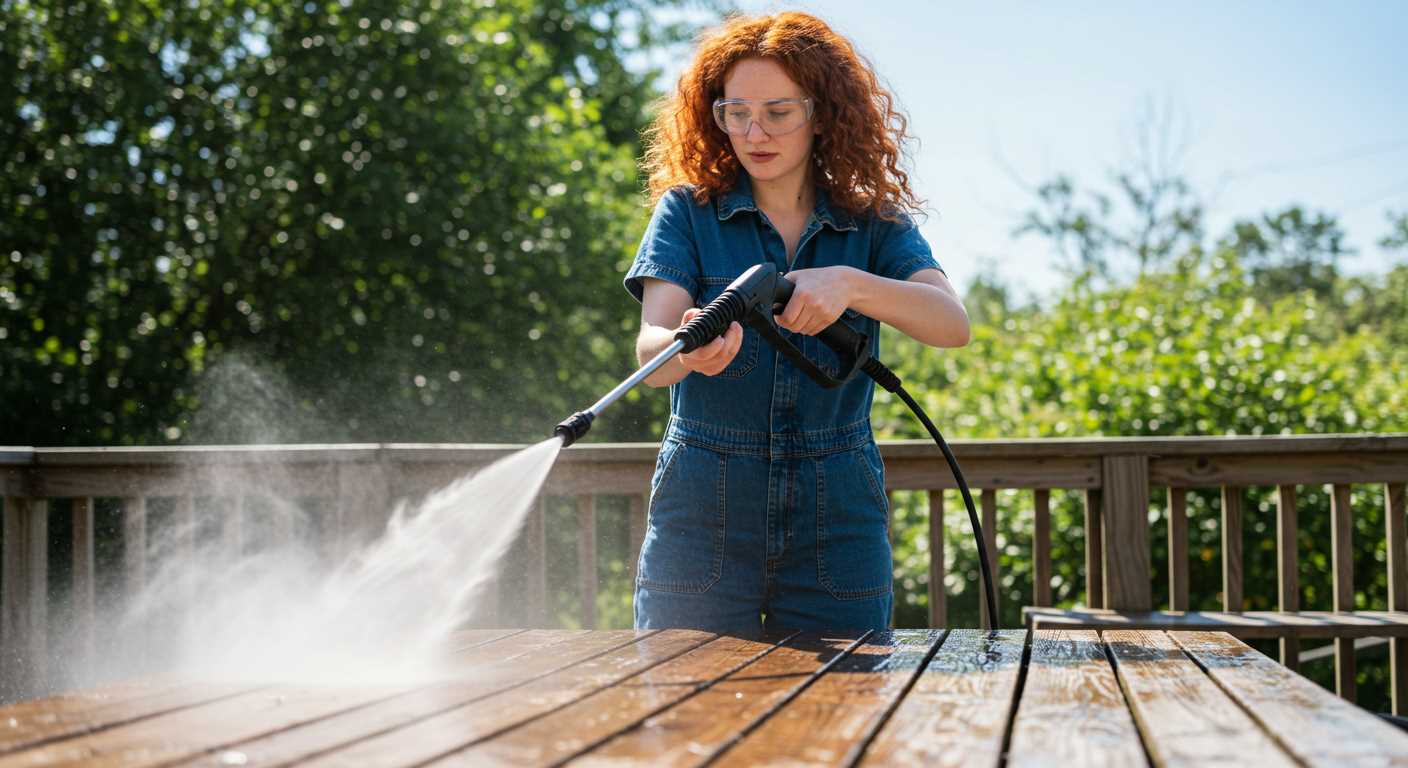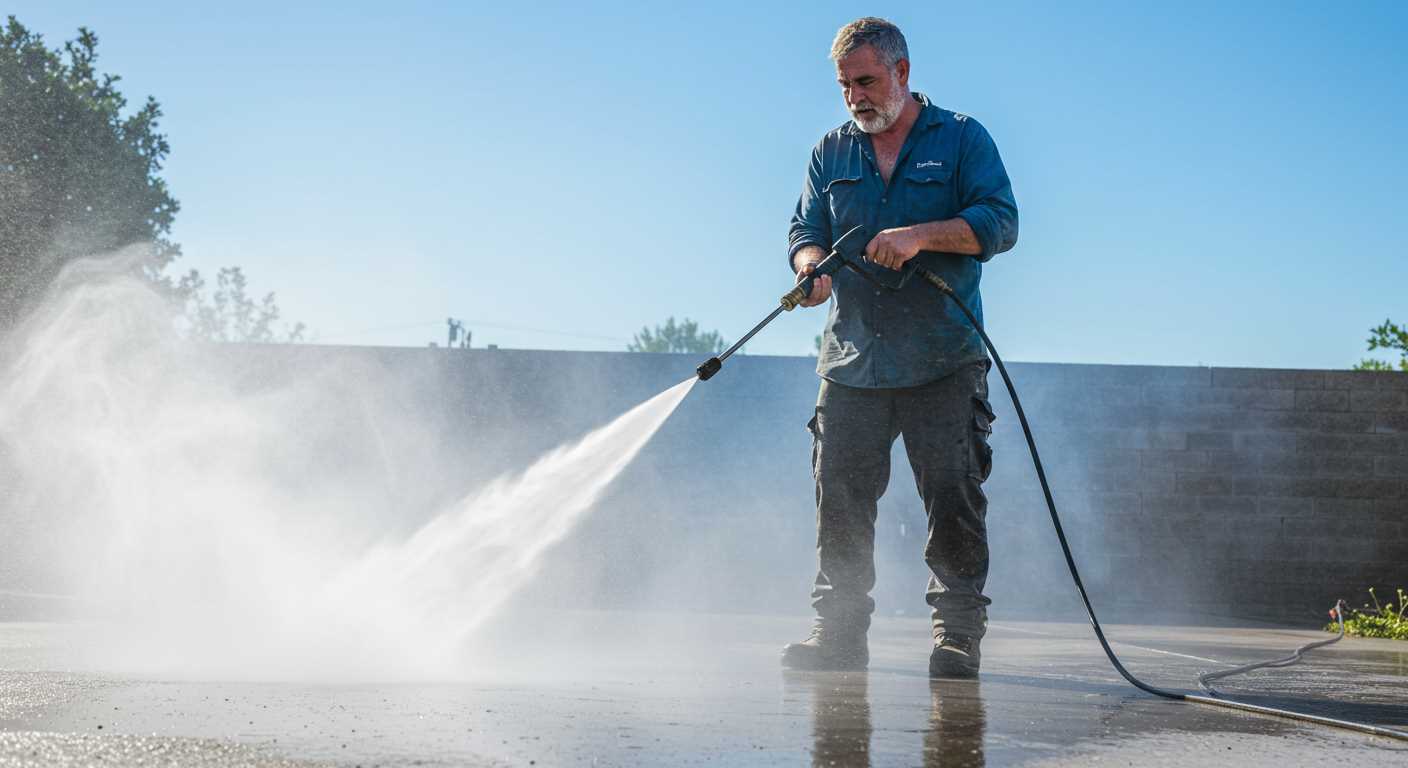


For those looking to elevate their cleaning game, attaching a turbo nozzle can be a game changer. This accessory transforms standard jets into a concentrated, rotating stream that tackles tough grime more efficiently.
During my years as a consultant, I vividly recall a particularly stubborn concrete patio that had seen better days. Armed with a turbo nozzle, I was able to strip away years of dirt and mildew in mere minutes. The key lies in maintaining the right distance from the surface; about 12 inches typically provides optimal results without causing damage.
Always begin with a low-pressure setting to avoid any mishaps. Gradually increase the power as you gauge the surface’s durability. Remember, technique matters–use a sweeping motion to ensure even coverage. This not only enhances effectiveness but also reduces the risk of streaking or etching.
Be mindful of the nozzle’s angle. A 25-degree nozzle is great for general cleaning, while a 15-degree option focuses on tougher stains. Switch between them as needed, and don’t hesitate to experiment to find the perfect fit for your specific project.
Selecting the Right Blast Attachment for Your Pressure Washer
Choosing the appropriate nozzle is crucial for achieving desired results. I remember testing various attachments, and each one had its own strengths. Start by assessing the surface you’ll clean.
- Surface Type: For delicate materials like wood or painted surfaces, opt for a gentler nozzle, usually in the range of 15° to 25°. For tough surfaces such as concrete or brick, a 0° or 15° nozzle is more suitable.
- Application: If you’re removing dirt from a driveway, a narrow spray pattern will focus the energy where it’s needed. For larger areas, a wider spray helps cover more ground quickly.
- Material Compatibility: Ensure the attachment is compatible with your equipment’s specifications. Using an incompatible nozzle can lead to damage or subpar performance.
During one of my projects, I used a 25° nozzle on a wooden deck. It worked wonders without stripping the wood’s finish. However, I switched to a 0° nozzle for a stubborn oil stain on concrete, and it blasted away the grime effortlessly.
Also, consider adjustable nozzles. They provide versatility by allowing you to switch between different spray patterns without needing to change attachments. This is particularly beneficial when tackling multiple surfaces in one session.
In terms of brand compatibility, I’ve found that sticking to the manufacturer’s recommendations ensures optimal results. Some attachments may seem universal, but subtle differences can affect performance.
Lastly, don’t underestimate the importance of maintenance. Clean your nozzles regularly to prevent clogs, which can lead to uneven cleaning or damage to your equipment.
Preparing Your Surface Before Using the Blast Attachment
Before you start, ensure the area is clear of any obstacles, such as furniture or tools. I once made the mistake of overlooking a few items in my backyard; the result was a mess and a delay in my task. Clear space allows for better access and efficiency.
Next, inspect the surface for any loose debris, dirt, or grime. A quick sweep or blow with a leaf blower can save you time later. I’ve found that tackling the obvious dirt first makes the cleaning process smoother. If you’re dealing with significant stains or build-up, pre-treat these areas with a suitable cleaner. I often use a degreaser for oil stains on concrete; it makes a noticeable difference.
Check for any fragile materials nearby. When I was cleaning an old patio, I didn’t consider the delicate flowers adjacent to the area. A slight miscalculation led to some unfortunate collateral damage. If you have plants, consider covering them or moving pots out of the way.
Ensure that the surface is structurally sound; look for cracks or loose tiles. I had an experience where I didn’t notice a cracked tile on my driveway, and the high velocity caused further damage. If repairs are needed, address them before proceeding.
Finally, gather all necessary equipment and ensure your cleaning solution is appropriate for the task. I once started a project only to realise I was out of the right cleaning agent. Having everything at hand helps maintain momentum and ensures a thorough clean.
Adjusting the Pressure Settings for Optimal Performance
Set the output force according to the task at hand. For tougher surfaces, such as concrete, I typically crank it up to the maximum level. However, for delicate materials like wood or painted surfaces, dial it back to prevent damage. I recall a time when I misjudged the settings while cleaning a wooden deck; the high force stripped away more than just dirt, leaving visible marks.
Understanding Settings
Each model has distinct pressure ranges. Familiarise yourself with your specific unit’s manual. Generally, a range of 1000 to 3000 PSI is common. For most tasks, a setting between 1500 and 2000 PSI works well. If unsure, start low and gradually increase until you find the sweet spot.
Testing and Adjusting

Before tackling the entire area, perform a quick spot test. Choose a small, inconspicuous section to gauge the results. Adjust the force based on your findings. A little trial and error can save time and prevent potential mishaps. I’ve often found that even a minor tweak can dramatically change the efficacy of cleaning.
| Surface Type | Recommended Pressure (PSI) |
|---|---|
| Concrete | 2500 – 3000 |
| Brick | 2000 – 2500 |
| Wood | 1500 – 2000 |
| Painted Surfaces | 1200 – 1500 |
| Vehicles | 1200 – 1900 |
Remember to always adjust the distance from the surface as you modify the settings. Closer contact means more force, while further away typically reduces impact. I’ve learned that maintaining a consistent distance during cleaning can enhance efficiency and ensure an even finish.
Proper techniques for using the blast attachment
Maintaining a consistent distance between the nozzle and the surface is critical. I’ve found that keeping it around 12 to 18 inches yields the best results without damaging the material. Too close, and you risk etching or stripping away layers; too far, and you lose efficiency. Always test a small, inconspicuous area first to assess how the surface reacts.
Angle and Movement
Utilising the correct angle is paramount. I typically hold the nozzle at a slight tilt–around 30 degrees–for optimal coverage. This angle helps to direct the force effectively while minimising splashback. Move in a sweeping motion, overlapping each pass slightly to ensure uniform cleaning. Rushing can lead to streaks or missed spots, so take your time to cover all areas thoroughly.
Technique Adjustments
Adjusting your technique based on the surface type can make a significant difference. For instance, when tackling concrete, I apply a back-and-forth motion, which allows the cleaning solution to penetrate better. On softer surfaces, like wood, I switch to a gentle, circular motion to avoid damage. Always keep an eye on the surface condition, and be ready to modify your approach if you notice signs of wear or damage.
Safety Precautions When Operating High-Pressure Equipment
Always wear safety goggles and heavy-duty gloves. These protect against debris and water jets. Never underestimate the power of the spray; it can cause serious injuries.
- Ensure footwear is slip-resistant. Wet surfaces can be treacherous.
- Check for tripping hazards in your work area. Clear away any obstacles before starting.
- Maintain a safe distance from the surface being cleaned. A good rule is at least two feet away.
- Do not point the nozzle at yourself or others, even if the device is turned off. Residual pressure can still cause harm.
Inspect the equipment before each use. Look for any signs of wear or damage, particularly in hoses and nozzles. A frayed hose can lead to sudden bursts of water that can be hazardous.
Consider the environment where you’re working. If it’s windy, debris can blow back toward you. Avoid operating near electrical outlets, as water and electricity do not mix. If using outdoors, ensure the area is well-ventilated.
Finally, if you’re using a budget pressure washer for car detailing, double-check the manufacturer’s guidelines regarding safety practices. Every model can have its unique requirements.
Cleaning and maintaining your blast attachment after use
After finishing your cleaning task, the first step is to disconnect the nozzle from the hose. This prevents any residual water from leaking out when you store it. Always remember to release any built-up pressure in the system by squeezing the trigger of the gun until no water sprays out.
Next, rinse the attachment thoroughly under running water. This removes any debris or grime that may have accumulated during your cleaning session. Pay special attention to the nozzle orifice; a clogged nozzle can significantly reduce performance. Use a soft brush or a toothpick to clear any stubborn blockages.
Inspect the attachment for wear or damage. Look for cracks or signs of deterioration in the plastic or rubber components. If you notice any issues, it’s wise to replace the part to avoid poor performance in future tasks.
After rinsing, allow the attachment to air dry completely. Storing it while damp can lead to mould or mildew growth, impacting its longevity. Make sure to keep it in a cool, dry place away from direct sunlight.
Regularly lubricating any moving parts will help maintain smooth operation. A small amount of silicone spray or similar lubricant on the joints can prevent rust and wear. Just a few drops will do; excess can attract dirt.
Lastly, keep a log of your maintenance routine. Jot down when you last cleaned and inspected the attachment. This will help you track its condition and remind you when it’s time for more thorough maintenance.
Troubleshooting common issues with the blast attachment
Encountering problems with your cleaning tool can be frustrating, but many issues are easily resolved with a bit of knowledge. One frequent concern is insufficient cleaning power. If you notice that dirt remains stubbornly on the surface, check the nozzle for clogs. A simple rinse with water can often clear blockages. Additionally, ensure that the unit is set to the correct pressure; too low and it won’t tackle grime effectively.
Inconsistent spray pattern
Another issue I’ve faced is an uneven spray pattern. This often results from a worn-out or damaged nozzle. Replacing the nozzle is typically a straightforward fix. Also, ensure that the connection between the tool and the hose is secure; a loose fitting can disrupt the flow and alter the spray. If you’re still experiencing problems, inspect the hose for kinks or leaks that may impede water flow.
Excessive vibration or noise
If the equipment is vibrating excessively or making unusual noises, check for loose components. Tighten any screws or bolts that may have come undone during operation. Sometimes, the surface itself can cause vibration; switching to a different area or surface type may alleviate the issue. Lastly, ensure that the tool is used on compatible materials, as this can affect performance and durability.
Always remember to clean your equipment after each session. A quick rinse can prevent residue buildup that may lead to these common problems. For a change of pace, you might enjoy exploring how to can chili without a pressure cooker. It’s a great way to apply some of that cleaning knowledge in the kitchen!
FAQ:
What is a pressure washer blast attachment and how does it work?
A pressure washer blast attachment is an accessory designed to enhance the cleaning power of a pressure washer. It typically consists of a nozzle that concentrates the water flow into a more powerful jet. This focused stream can remove stubborn dirt, grime, and stains from surfaces like driveways, patios, and vehicles. The attachment works by increasing the pressure of the water as it exits the nozzle, allowing for a more intense cleaning action compared to standard nozzles.
Can I use a blast attachment on any surface?
While a blast attachment can be very effective, it’s important to consider the surface you are cleaning. It works well on hard surfaces such as concrete, brick, and stone. However, using it on delicate surfaces like wood or painted surfaces can cause damage. Always check the manufacturer’s guidelines for both the pressure washer and the attachment, and test on a small, inconspicuous area first to ensure compatibility.
How do I properly attach the blast attachment to my pressure washer?
Attaching a blast attachment is generally straightforward. First, ensure that your pressure washer is turned off and unplugged. Then, remove the existing nozzle from the wand by twisting or pulling it off, depending on the model. Next, take the blast attachment and securely fasten it to the wand by following the specific connection method outlined in your pressure washer’s manual. Once attached, check for any leaks by turning on the water supply and briefly running the washer without power.
What safety precautions should I take when using a pressure washer blast attachment?
Safety is paramount when using a pressure washer, especially with a blast attachment. Always wear protective gear, including safety goggles and gloves, to shield yourself from debris and high-pressure water. Keep bystanders and pets at a safe distance while operating the equipment. Avoid pointing the nozzle at yourself or others, and be cautious of slippery surfaces. Additionally, never use the attachment while standing on a ladder or unstable surface to prevent falls.
How do I maintain my pressure washer and blast attachment to ensure they last longer?
Regular maintenance is key to extending the lifespan of both your pressure washer and blast attachment. After each use, rinse the attachment to remove any dirt or debris, and check for clogs in the nozzle. Store the equipment in a dry place to prevent rust and damage. Periodically inspect hoses and connections for leaks, and replace any worn parts as needed. Following the manufacturer’s maintenance guidelines will also help keep your equipment in optimal condition.





.jpg)


